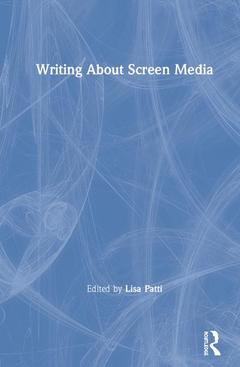Description
Writing About Screen Media
Coordinator: Patti Lisa
Language: English
Subjects for Writing About Screen Media:
Keywords
Dissertation Writing Group; Young Man; Film Studies; Grand Theft Auto; Looking at Movie; DVD Commentary; Writing About Movies; Media History Digital Library; writing about videogames; DVD Release; introduction to film studies; Webster City; Lisa Patti; Watermelon Woman; Film Studies: A Global Introduction; Boing Boing; Corrigan; Pop Star; A Short Guide to Writing About Film; Video Essays; Bombay cinema credit sequences; Found Footage Films; screen media objects; Tv Globo; K-pop music videos; Brazilian Telenovelas; global streaming services; MC Hammer; Media Franchises; Hindi Film Industry; Credit Sequences; Losing Ground; Gangnam Style; Book Review Editor; Found Footage; Orphan Black; Screen Media; Outdoor Advertisements
Publication date: 07-2019
· 15.6x23.4 cm · Hardback
Publication date: 08-2019
· 15.6x23.4 cm · Paperback
Description
/li>Contents
/li>Readership
/li>Biography
/li>
Writing About Screen Media presents strategies for writing about a broad range of media objects ? including film, television, social media, advertising, video games, mobile media, music videos, and digital media ? in an equally broad range of formats.
The book?s case studies showcase media studies? geographical and industrial breadth, with essays covering topics as varied as: Brazilian telenovelas, K-pop music videos, Bombay cinema credit sequences, global streaming services, film festivals, archives, and more. With the expertise of over forty esteemed media scholars, the collection combines personal reflections about writing with practical advice. Writing About Screen Media reflects the diversity of screen media criticism and encourages both beginning and established writers to experiment with content and form.
Through its unprecedented scope, this volume will engage not only those who may be writing about film and other screen media for the first time but also accomplished writers who are interested in exploring new screen media objects, new approaches to writing about media, and new formats for critical expression.
Part I. New Frameworks for Writing about Screen Media
1. Introduction, Lisa Patti
(Still) Learning to Write about Screen Media
How to Read This Book
In Practice
2. The Big Picture: Strategies for Writing about Screen Media, Lisa Patti
Collaborate
Frame
Curate
Follow (up)
In Practice
3. From Screen Aesthetics to Site Design: Analyzing Form Across Screen Media, Lisa Patti
Taking Notes
Close Readings: Case Studies
In Practice
4. Entering the Conversation: How and Where to Develop a Critical Argument, Lisa Patti
What is an Argument?
Thinking on the Page: Free Writing
Structuring Your Argument: Outlines
Setting the Scene: Introductions
Telling a Story: Evidence
Making a Last(ing) Impression: Conclusions
In Practice
5. From Notebook to Network: When and How to Use Digital Tools, Lisa Patti
Digital Resources: Reading, Watching, Writing
In Praise of Paper
Citation
Fair Use
In Practice
Part II. Writers on Writing about Screen Media
OBJECTS AND EVENTS
6. Writing about Transnational Cinema: Crazy Rich Asians
Olivia Khoo
7. Capturing Moments: Writing about Film Festivals as Events
Kirsten Stevens
8. Writing about Experimental Cinema: Andy Warhol’s Empire (1964)
Glyn Davis
9. From Meaning to Effect: Writing about Archival Footage
Jaimie Baron
10. Making the Absent Present: Writing about Nonextant Media
Allyson Nadia Field
11. Expressing Race in Brazilian Telenovelas
Jasmine Mitchell
12. Writing about Music Video: Tracing the Ephemeral
Carol Vernallis
13. Writing Across Divides: Locating Power in K-pop Music Videos
S. Heijin Lee
14. Playing to Write: Analyzing Video Games
TreaAndrea M. Russworm and Jennifer Malkowski
15. When It All Clicks: Writing about Participatory Media
Lauren S. Berliner
16. Feeling Out Social Media
Julie Wilson and Emily Chivers Yochim
17. "A Very Black Project": A Method for Digital Visual Culture
Lauren McLeod Cramer
18. Writing about Transnational Media: From Representation to Materiality
Fan Yang
19. Writing about Digital and Interactive Media
Dale Hudson and Patricia R. Zimmermann
20. (Un)Limited Mobilities
Rahul Mukherjee
21. Context is Key: How (and Why) You Should Write about Outdoor Advertising
Beth Corzo-Duchardt
METHODS AND LOCATIONS
22. How Sound Helps Tell a Story: Sound, Music, and Narrative in Vishal Bhardwaj’s Omkara
Nilanjana Bhattacharjya
23. Writing Outside the Text: A Cultural Approach to Exhibition and Moviegoing
Jasmine Nadua Trice
24. Writing about Streaming Portals: The Drama of Distribution
Ramon Lobato
25. Analyzing and Writing about Credit Sequences
Monika Mehta
26. "We Are Not Thinking Frogs": The Archive, the Artifact, and the Task of the Film Historian
Katherine Groo
27. Show Me the Data!: Uncovering the Evidence in Screen Media Industry Research
Bronwyn Coate and Deb Verhoeven
28. Researching and Writing Across Media Industries
Derek Johnson
29. The Value of Surprise: Ethnography of Media Industries
Tejaswini Ganti
30. Listen Up!: Interviewing as Method
Alicia Kozma
31. The Need for Translation: Difference, Footnotes, Hyperlinks
Tijana Mamula
FORMS AND FORMATS
32. Words and More: Strategies for Writing about and with Media
Virginia Kuhn
33. Best Practices for Screen Media Podcasting
Christine Becker and Kyle Wrather
34. Confessions of an Academic Blogger
Henry Jenkins
35. The Research and the Remix: Video Essays as Creative Criticism
Jeffrey Middents
36. Foregrounding the Invisible: Notes on the Video Essay Review
Chiara Grizzaffi
37. Review, Edit, Repeat: Writing and Editing Book Reviews
Alice Leppert
38. Extracurricular Scholarship: "Writing" My Audio Commentary of Losing Ground
Terri Francis
39. The Short, Sweet Art of Blurb Writing
Leah Shafer
40. Bridging the Gaps Between Scholarly Essays and Mass-Market Film Writing
Nick Davis
41. Writing Across the Page Without a Line
Holly Willis
Lisa Patti is Associate Professor in the Media and Society Program at Hobart and William Smith Colleges. She is co-author (with Glyn Davis, Kay Dickinson, and Amy Villarejo) of Film Studies: A Global Introduction (2015) and co-editor (with Tijana Mamula) of The Multilingual Screen: New Reflections on Cinema and Linguistic Difference (2016).




